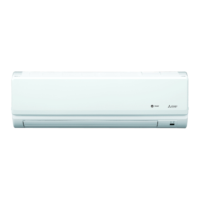Z
zwashingtonSep 7, 2025
Why does the set temperature change when drying mode starts on my Mitsubishi Electric?
- CChelsey HamiltonSep 7, 2025
When Drying mode starts, the set temperature automatically changes to the optimum initial set temperature.

Why does the set temperature change when drying mode starts on my Mitsubishi Electric?
When Drying mode starts, the set temperature automatically changes to the optimum initial set temperature.
Why is my Mitsubishi Electric Trane TPKA0A0361KA70 not blowing warm air immediately when heating operation starts?
Warm air will not be emitted from your Mitsubishi Electric Heat Pump until the indoor unit has warmed up sufficiently.
Why does Mitsubishi Electric Trane TPKA0A0361KA70 Heat Pump air direction change during operation?
During cooling mode, the vanes automatically move to the horizontal (down) position after 1 hour when the down (horizontal) airflow up/ down direction is selected. During heating mode, the vanes automatically move to the horizontal airflow up/down direction when the airflow temperature is low or during defrosting mode.
Why does my Mitsubishi Electric Trane TPKA0A0361KA70 Heat Pump make cracking or creaking sounds?
These sounds can occur when parts rub against each other due to expansion and contraction caused by temperature changes.
Why does Mitsubishi Electric Heat Pump emit a white mist or vapor from the indoor unit?
A white mist or vapor may be emitted from the indoor unit of your Mitsubishi Electric Heat Pump under these conditions: * If the indoor temperature and humidity are high, this can occur when operation starts. * During defrosting mode, cool airflow may blow down and appear like a mist.
Why does Mitsubishi Electric Trane TPKA0A0361KA70 Heat Pump stop before reaching set temperature in heating mode?
Your Mitsubishi Electric Heat Pump might stop before reaching the set room temperature during heating mode because when the outdoor temperature is low and the humidity is high, frost may form on the outdoor unit. If this occurs, the outdoor unit will perform a defrosting operation, and normal operation should resume after approximately 10 minutes.
What does it mean when “PLEASE WAIT” appears on Mitsubishi Electric wired remote controller display?
When “PLEASE WAIT” is displayed on your Mitsubishi Electric wired remote controller, it indicates that the initial settings are being configured. Please wait approximately 3 minutes for the process to complete.
Why is my Mitsubishi Electric Heat Pump louder than specified?
The indoor operation sound level is affected by the acoustics of the particular room as shown in the following table and will be higher than the noise specification, which was measured in an echo-free room.
Why do I hear draining water or motor rotation sound from Mitsubishi Electric Trane TPKA0A0361KA70 Heat Pump?
When cooling operation stops, the drain pump operates and then stops. Wait approximately 3 minutes.
Why does Mitsubishi Electric Trane TPKA0A0361KA70 air direction always move past the set position?
When the airflow up/down direction is changed, the vanes move to the set position after detecting the base position.
| Model Number | TPKA0A0361KA70 |
|---|---|
| Category | Heat Pump |
| Brand | Mitsubishi Electric Trane |
| Cooling Capacity (BTU/h) | 36, 000 |
| Heating Capacity (BTU/h) | 36, 000 |
| SEER Rating | 16 |
| HSPF Rating | 9.0 |
| Voltage (V) | 208/230 |
| Phase | 1 |
| Refrigerant Type | R-410A |
| Operating Temperature Range (Cooling, °F) | 14 to 115 |
| Indoor Unit Compatibility | Compatible with various indoor units |
Details parts of the indoor unit for TPKA0A/TPCA0A models, including fan, vane, and filter.
Identifies components and buttons of the wired and IR wireless remote controllers.
Instructions on how to start and stop the air conditioner operation using the ON/OFF button.
Guides on choosing between Cool, Heat, Auto, Drying, and Fan modes.
Details how to adjust the desired temperature for different operation modes.
Describes how to operate the unit using emergency buttons when the remote is unavailable.
Addresses issues with heating/cooling, airflow, operational sounds, and smells.












